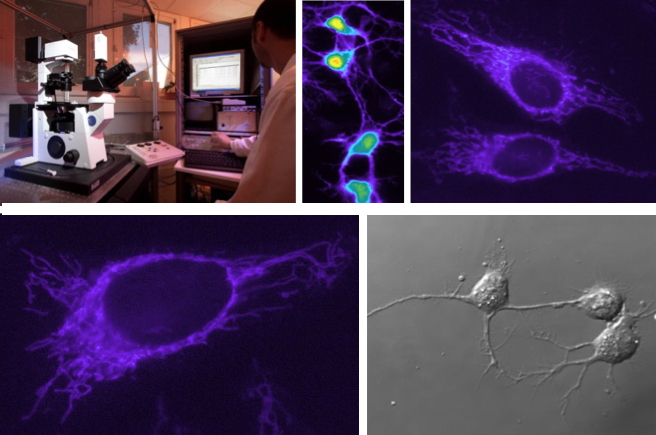 Current activity
Current activity
The main objective of the current project is to investigate the mechanisms by which deubiquitinating enzymes regulate calcium signaling in neurons of the central nervous system.
Calcium (Ca
2+) is a universal and multipurpose intracellular second messenger controlling a myriad of biological processes. It is involved in nearly every aspect of brain cell development and functions such as cell division, cell fate and survival, migration, differentiation or synaptic transmission. To fulfill all these tasks, neuronal cells express a large repertoire of proteins participating in the uptake, extrusion, storage, release, and buffering of Ca
2+. These proteins form an extensive and intricate system allowing a precise and highly efficient spatio-temporal regulation of the Ca
2+ transport and signaling. Amongst the various proteins participating in the cellular homeostasis of Ca
2+, Ca
2+-conducting channels constitute an important group. They function as pores inserted into biological membranes and permitting the uptake (from the extracellular fluid) or the release of Ca
2+ (from internal stores). Ca
2+-conducting channels contribute to elevate the cytosolic concentration of free Ca
2+ and thus exert key biological roles. Furthermore, alterations in Ca
2+ homeostasis can have detrimental effects on cellular functions and survival. There is now growing evidence linking impairment in neuronal Ca
2+ signalling and many neurodegenerative diseases (see for instance Alzheimer’s Association Calcium Hypothesis Workgroup. 2017.
Calcium Hypothesis of Alzheimer’s disease and brain aging: A framework for integrating new evidence into a comprehensive theory of pathogenesis.
Alzheimer's & Dementia)
Ubiquitination is a post-translational protein modification consisting in the covalent binding of the polypeptide ubiquitin (Ub) to target proteins. The conjugation of Ub is a multi-step reaction that can be reversed by proteases named deubiquitinating enzymes (DUBs). The ubiquitination status of cells is a prominent and highly dynamic biological parameter that governs proteolytic and non-proteolytic processes that are essential for the cellular homeostasis. Impairments of the cellular ubiquitination status and of the homeostasis of Ca
2+ are two hallmarks of many neurodegenerative disorders. However, very little is known about the control of the Ca
2+ signalling by the ubiquitin system in central nervous system neurons. Our current project plans to address this issue, using live-cell imaging techniques with fluorescence Ca
2+ probes, and pharmacological and biochemical approaches. Most of the experiments are carried-out on primary cultures of cortical neurons.
 Techniques and equipment
Techniques and equipment We use imaging methods on living cells (cell lines like HEK-293 or HeLa cells, and cortical neurons in primary cultures). The lab has a live-cell imaging setup comprising an inverted Carl Zeiss Axio Observer A1 microscope equipped with a Fluar 40x oil immersion objective lens (1.3 NA) + the DG-4 wavelength switcher (Princeton Instruments) + a cooled CCD camera CoolSnap HQ2 (Princeton Instruments). Images are acquired and analyzed with the MetaFluor software (Universal Imaging).
The lab is also equipped with a patch-clamp setup consisting of an inverted Olympus IX 51 microscope + an Axoclamp 200B amplifier (Axon Instruments) + a motorized micromanipulator (Luigs & Neumann) + a pipette puller (DMZ Universal Puller, Zeitz Instruments). This patch-clamp setup is driven by the Axoclamp software.

 Publications (2018 – Present)
Publications (2018 – Present)
•
Bouron A. Store-operated ion channels: A growing family?
Cell Calcium, 2022,
107: 102657
•
Bouron A, Fauvarque MO. Genome-wide analysis of genes encoding core components of the ubiquitin system during cerebral cortex development.
Molecular Brain, 2022,
15: 72
• Busser B, Bulin AL, Gardette V, Elleaume H, Pelascini F,
Bouron A, Motto-Ros V, Sancey L. Visualizing the cerebral distribution of chemical elements: A challenge met with LIBS elemental imaging.
Journal of Neuroscience Meththods, 2022,
379: 109676
•
Bouron A. Transcriptomic profiling of Ca
2+ transport systems during the formation of the cerebral cortex in mice.
Cells, 2020,
9(8): 1800
• Deveci A, Hasna J,
Bouron A. Inhibition of store-operated calcium channels by N-arachidonoyl glycine (NAGly): no evidence for the involvement of lipid-sensing G protein coupled receptors.
Scientific Reports, 2020,
10(1): 2649
• Hasna J, Bohic S, Lemoine S, Blugeon C,
Bouron A. Zinc uptake and storage during the formation of the cerebral cortex in mice.
Molecular Neurobiology, 2019,
56(10): 6928-6940
• Hasna J, Abi Nahed R, Sergent F, Alfaidy N,
Bouron A The deletion of TRPC6 channels perturbs iron and zinc homeostasis and pregnancy outcome in mice.
Cellular Physiology and Biochemistry,, 2019,
52(3): 455-467
• Fus F, Yang Y, Lee HZS, Top S, Carriere M,
Bouron A, Pacureanu A, da Silva JC, Salmain M, Vessières A, Cloetens P, Jaouen G, Bohic S. Intracellular localization of an osmocenyl-tamoxifen derivative in breast cancer cells revealed by synchrotron radiation X-ray fluorescence nanoimaging.
Angewandte Chemie International Edition, 2019,
58(11): 3461-3465
• Pochwat B, Szewczyk B, Kotarska K, Rafało-Ulińska A, Siwiec M, Sowa JE, Krzystof Tokarski K, Siwek A,
Bouron A, Friedland K, Nowak G. Hyperforin potentiates antidepressant-like activity of lanicemine in mice.
Frontiers in Molecular Neuroscience, 2018,
11: 456
•
Bouron A. Phyto and endocannabinoids exert complex actions on calcium and zinc signaling in mouse cortical neurons.
Biochemical Pharmacology, 2018,
152: 244–251
 Fundings
Fundings
- 2021: Université Grenoble Alpes, 2021-2022
- 2016: ANR, 2017-2021
- 2014: ERA-NET Neuron, 2014-2017
 Collaborations
Collaborations
- Dr. M. Gersch, Max Planck Institute of Molecular Physiology, Dortmund, Germany
- Dr. X. Jacq, Almac Discovery, Craigavon, U.K.
- Prof. C. Meyer-Schwesinger, University Medical Center Hamburg-Eppendorf, Hamburg, Germany
- Prof G. Nowak, Institute of Pharmacology, Cracow, Poland
- Prof. E. Tate, Imperial College London, U.K.